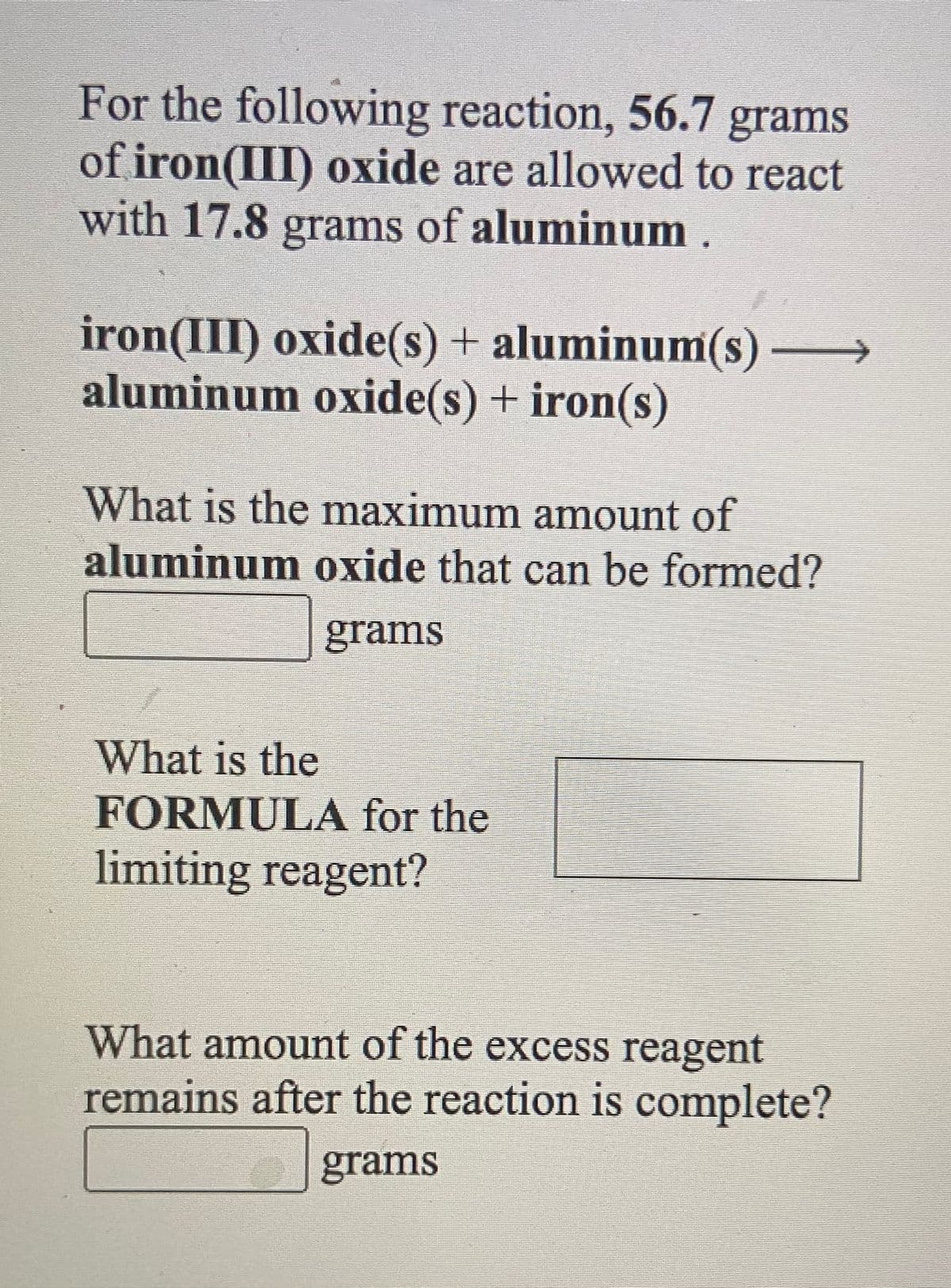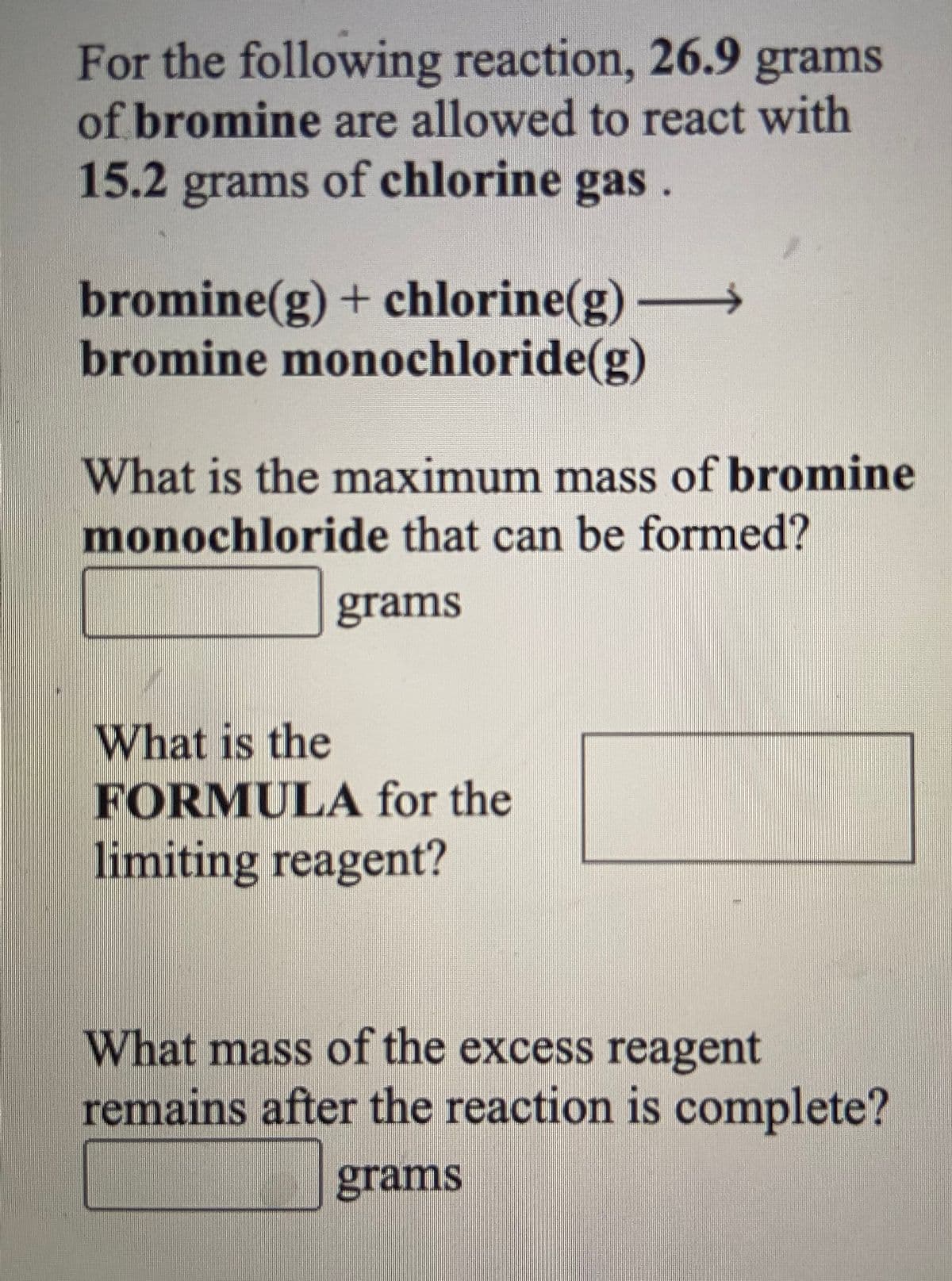For the following reaction, 56.7 grams of iron(III) oxide are allowed to react with 17.8 grams of aluminum . iron(III) oxide(s) + aluminum(s)→ aluminum oxide(s) + iron(s) What is the maximum amount of aluminum oxide that can be formed? grams What is the FORMULA for the limiting reagent? What amount of the excess reagent remains after the reaction is complete? grams
For the following reaction, 56.7 grams of iron(III) oxide are allowed to react with 17.8 grams of aluminum . iron(III) oxide(s) + aluminum(s)→ aluminum oxide(s) + iron(s) What is the maximum amount of aluminum oxide that can be formed? grams What is the FORMULA for the limiting reagent? What amount of the excess reagent remains after the reaction is complete? grams
Chemistry: An Atoms First Approach
2nd Edition
ISBN:9781305079243
Author:Steven S. Zumdahl, Susan A. Zumdahl
Publisher:Steven S. Zumdahl, Susan A. Zumdahl
Chapter5: Stoichiometry
Section: Chapter Questions
Problem 116E: Consider the following reaction: 4NH3(g)4NO(g)+6H2O(g) If a container were to have 10 molecules of...
Related questions
Question

Transcribed Image Text:For the following reaction, 56.7 grams
of iron(III) oxide are allowed to react
with 17.8 grams of aluminum .
iron(III) oxide(s) + aluminum(s) –
aluminum oxide(s) + iron(s)
What is the maximum amount of
aluminum oxide that can be formed?
grams
What is the
FORMULA for the
limiting reagent?
What amount of the excess reagent
remains after the reaction is complete?
grams

Transcribed Image Text:For the following reaction, 26.9 grams
of bromine are allowed to react with
15.2 grams of chlorine gas.
bromine(g)+ chlorine(g)
bromine monochloride(g)
What is the maximum mass of bromine
monochloride that can be formed?
grams
What is the
FORMULA for the
limiting reagent?
What mass of the excess reagent
remains after the reaction is complete?
grams
Expert Solution
This question has been solved!
Explore an expertly crafted, step-by-step solution for a thorough understanding of key concepts.
This is a popular solution!
Trending now
This is a popular solution!
Step by step
Solved in 3 steps with 3 images

Knowledge Booster
Learn more about
Need a deep-dive on the concept behind this application? Look no further. Learn more about this topic, chemistry and related others by exploring similar questions and additional content below.Recommended textbooks for you

Chemistry: An Atoms First Approach
Chemistry
ISBN:
9781305079243
Author:
Steven S. Zumdahl, Susan A. Zumdahl
Publisher:
Cengage Learning

Chemistry: The Molecular Science
Chemistry
ISBN:
9781285199047
Author:
John W. Moore, Conrad L. Stanitski
Publisher:
Cengage Learning

Chemistry for Engineering Students
Chemistry
ISBN:
9781337398909
Author:
Lawrence S. Brown, Tom Holme
Publisher:
Cengage Learning

Chemistry: An Atoms First Approach
Chemistry
ISBN:
9781305079243
Author:
Steven S. Zumdahl, Susan A. Zumdahl
Publisher:
Cengage Learning

Chemistry: The Molecular Science
Chemistry
ISBN:
9781285199047
Author:
John W. Moore, Conrad L. Stanitski
Publisher:
Cengage Learning

Chemistry for Engineering Students
Chemistry
ISBN:
9781337398909
Author:
Lawrence S. Brown, Tom Holme
Publisher:
Cengage Learning


Chemistry
Chemistry
ISBN:
9781305957404
Author:
Steven S. Zumdahl, Susan A. Zumdahl, Donald J. DeCoste
Publisher:
Cengage Learning

World of Chemistry, 3rd edition
Chemistry
ISBN:
9781133109655
Author:
Steven S. Zumdahl, Susan L. Zumdahl, Donald J. DeCoste
Publisher:
Brooks / Cole / Cengage Learning